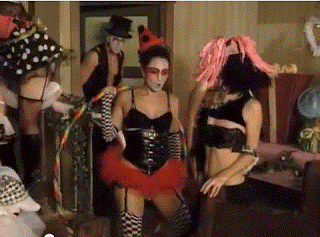Today music videos accompany almost every chart song and are
seen as a vital part to the promotion and selling of the song due to the
fascinating eye catching effects and conventions used to attract audience. The
first music videos and promos were filmed in the mid 1950’s however this was a
development from as early as the 1920’s where short animation films were
accompanied by music, this was called ‘visual music’.
In 1964 ‘The Beatles’ released one of the first major music
videos ‘A Hard Day’s Night’ directed by ‘Richard Lester’. This had major impact
on the music industry and was the real starting point to music videos becoming
a vital part of the music society due to the huge interest the band gained from
the new element of a short film especially designed to accompany a song. This
videos main narrative and focus was on the bands live performance in front of a
studio audience which is still a common convention used in new music videos we
see today. The video was also filmed in black and white and introduced purposely
shakey camera movement which might be seen as a clever technique to show atmosphere
from point of view or even to keep pace within the video.
Due to the interest ‘The Beatles’ gained from their music
video, the popular TV comedy ‘The Monkees’ following the adventurous lives of
four young men decided to introduces specially made film segments to accompany
Monkees songs used in the series; this was the start to the development of the
music video genre.
Yet again ‘The Beatles’ raised the bar with their new music
videos for ‘Strawberry Fields Forever’ and ‘Penny Lane’ as they started to
introduce new filming elements such as dramatic lighting, special effects,
different camera shots and angles, and started editing their video to the beat
of the song. This created a stronger link between the music and video by illustrating
the song through a visual narrative rather than just showing the band playing
live; this is where the cut always between the band playing live and
illustrative clips relating to the song that we see today come from.
 |
|
As music videos started to be more commonly developed they
started to be shown commonly in cinemas and as technology improved a huge
inspiration for the music industry to create videos was the brand new program
introduced called ‘Top Of The Pops’. This started to create competition within
the music industry due to the concept that it would play the top music charts
with their accompanying videos; this helped increase songs sales as viewers
wanted to see the videos they enjoyed on the next episode of the program.
In 1975 the band ‘Queen’ had impact with their music video
for ‘Bohemian Rhapsody’ as they decided to use TV networks to their advantage
by giving them their video for free in a clever plot to make more money in
sales due to the audience they would attract by the networks playing the video.
In 1981 MTV was launched, a channel devoted to music due to
the widening field for money in music videos and the still rising competition
in the music industry. This created an even fiercer competition for bands to
create eye catching videos with the new technology of camera, lighting, special
effects.
‘Michael Jacksons’ ‘Thriller’ yet again added new
development into the music video by producing a full small narrative that had a
start and finish that was displayed through video and described through song.
This video was 15 minutes long and cost millions of pounds to make, the video
started of the imitable dance that is still related to the song today.
‘Duran Duran’ created impact in the music video industry by
introducing explicit censored content into their video. This was done to play
to their advantage by creating controversy and publicity for the band, hence
promoting the release and attracting audience in a different manor. This helped
define the genres of music video that we see today in the way that different
genre’s of song will use stereotypes and include similar content throughout
that genre. For instance in a rap music video, as an audience we expect to see
more explicit content than the video of a pop song.
These early on developments are the footings to the
conventional elements we expect to see in the music videos today however due to
new developments it has become apparent that music videos do not have to follow
conventions to be a good video as some of the best videos break many
conventions in artistic ways that grab viewers attention.
Today music videos are extremely popular and primarily for
promotion purposes; with new technologies of the internet and sites such as ‘Vimeo’
and ‘Youtube’, music videos are easily accessible and are viewed by millions.
TV channels such as MTV still continue to run and play music videos
continuously to certain audiences that enjoy watching the narrative of the
videos along with hearing the music.











